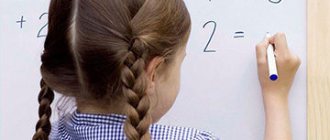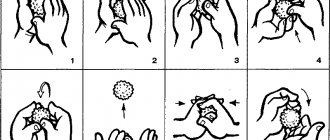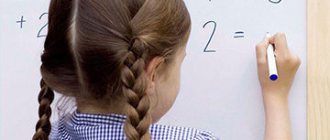Counting is one of the basic skills that it is advisable to master before the child goes to school. No one will require a first-grader to solve complex examples - but learning to count the number of objects and knowing the basics of addition and subtraction before school will be useful. The child will not have difficulty understanding the teacher’s requests - for example, “take two pencils” - and the first grader will not feel less smart than peers who have already learned to count.
When sending your child to school, take care not only of his intellectual preparation. After all, at school the child will encounter a whole new world. Some children have a hard time with the adaptation period. The “Where are my children” application will help you make sure that your child is not bullied by peers or teachers, that he has no problems and that he is safe!
There are many ways to teach a child to count: using methods developed by professional teachers, in a playful way, using rhymes and thematic videos. Whichever method you choose, learning to count can be considered the first step to learning mathematics. A good knowledge of mathematics is the key to not only positive grades, but also excellent memory and attention, developed logical thinking, and the ability to calculate the right decision in any situation.
First acquaintance with numbers: when and where to start
You can start introducing your baby to numbers at the age of 1.5-2 years. But it is too early to expect significant mathematical success from a small child, although children quickly understand the difference between the concepts of “one” and “many” even at an early age.
Briefly about the stages of a child learning to count - in the table:
Trying to teach a child to count too early is not worth it because of the differences in children's thinking from that of adults. There is such a thing as Piagetian phenomena, proven by the French psychologist Jean Piaget.
The psychologist has proven that children under six years old cannot treat counting abstractly, considering a mathematical operation to be correct only in the present tense and precisely with those objects that an adult shows. For example, a child under six years old will be convinced that if he takes the apples to another room, or replaces the apples with pears, the number of objects will change.
The best way to teach children to count is in 4 stages:
- At 2-3 years old it is enough to teach a child to understand the difference between “little” and “many”.
- At 4-5 years old, it’s time to learn to count concrete, not abstract, objects within 10: candy in a vase, plates on the table, books on a shelf.
- At 5-6 years old, a child can be taught to count to 10 and 20, and show how numbers look and are written. At the same age, the baby is already able to understand the terms “more and less,” adding the right amount to objects or, conversely, removing the excess to achieve equality (for example, arranging toys in equal piles).
- By the age of 6-7 years, the child is ready to learn to count to 100, and add and subtract numbers up to 10.
Features of teaching children to count
Unfortunately, there is no consensus on teaching children the science of counting. For example, a famous teacher, Doctor of Pedagogical Sciences and a recognized specialist in preschool education, Anna Mikhailovna Leushina, believed that there is no need to rush too much when learning to count, and that one should teach counting only after the simplest operations on sets have been mastered.
The fact is that counting is an activity that has its own specific characteristics, namely: purpose, means, methods of implementation and results, expressed in the form of a final number as an indicator of the power of the set.
The meaning of counting as an activity is to establish a one-to-one interaction between the elements of a certain set and the numbers of the natural series as a standard set of numbers, where all these numbers reflect a certain class of sets.
A huge amount of psychological and pedagogical research conducted at one time by such specialists as V.V. Danilova, G.S. Kostyuk, A.M. Leushina and others showed that children begin to master counting gradually, and this process itself goes through a number of stages .
How to teach counting to 10
You can teach your child to count to 10 before the age of five, or, if necessary, at an older age. The main conditions for successfully teaching mental counting to 10 are a child’s good vocabulary and interest in numbers.
How to teach your child to count to 10:
- focus on numbers that you already use in everyday situations, for example: “You are four years old now, and will soon be five years old,” “It’s time to get up, it’s already seven o’clock”;
- show images with different numbers of objects within 10: illustrations in books, cubes, your own drawings;
- educational videos and cartoons on the relevant topic will help you quickly remember the sequence of counting to 10;
- connect elements of mental arithmetic: teach your child to use an abacus - often children quickly master counting within 10 by practicing with abacus abacus, or even with classic wooden abacus;
- use an element of the Montessori method: the famous teacher successfully taught counting to children aged 3-6 years, regardless of their initial abilities, using the most visual practical material - money (Maria Montessori considered money exchange exercises to be the most effective activity for understanding counting).
When sending your child to school, take care not only of his intellectual preparation. After all, at school the child will encounter a whole new world. Some children have a hard time with the adaptation period. The “Where are my children” application will help you make sure that your child is not bullied by peers or teachers, that he has no problems and that he is safe!
How to teach counting to 20
You can teach your child to count to 20 when he can confidently count to 10. To quickly and easily master counting to 20, proceed in the following sequence:
- Tell your child what zero is (if he doesn’t already know) using visual examples. For example, show two books or two other identical objects, and then remove them. Explain that there were two books, and now there are zero.
- Show how new numbers are formed - it will be easier for the child to understand the principle using the example of numbers ending in zero. Tell us that in Old Russian “dtsat” means ten and, accordingly, the number 20 is two tens (you need to count to ten twice).
- Introduce your child to the concept of “number composition” - also with the help of improvised objects: counting sticks, toys, fruits. Place 10 identical objects in one row, and on top place an object different from these ten, for example, a counting stick of a different color. Explain to your child that the number is eleven. By adding sticks on top, show how you get 12, 13, 14, and the rest of the numbers up to 20.
- Give your child the task of collecting a certain number of identical objects (16, 17, 18, etc.), for example, small toys, and together count the number of objects out loud.
- Reinforce the material using a number line from 0 to 20 - this way your child will learn to count to 20 much faster. You can draw a number line yourself or use a ruler 20 centimeters long. By practicing with a ruler, the baby will gradually remember how to write numbers and their correct sequence.
When to start teaching children to count. Initial teaching methods
As has already become clear, it is better not to rush into learning counting as such, but you still need to gradually prepare your child to master counting. Here's a system you can follow:
- The baby is not yet a year old. The child’s brain is not yet ready to fully perceive information, so there is no point in teaching counting. It is optimal to play with fingers, develop fine motor skills, and form creative thinking. You can read nursery rhymes to your baby by bending your fingers, without focusing on the numbers. The child must understand that playing with mom or dad is very fun and interesting.
- Period from 1 to 3 years. Introduce your little one to what little and much are. For example, one toy is in a pen, but there are many toys in a box. Use dolls, nesting dolls, cars and other toys that easily fit into a child's hand. There is no need to conduct classes for a long time, otherwise the child will quickly get tired. As soon as you see that interest has disappeared, take up another activity.
- Period from 3 to 4 years. Move on to the comparison. In the process, you can use absolutely anything that can be compared. Offer your baby objects of different sizes and in different quantities.
- Period from 4 to 5 years. Start counting little by little. It is convenient to start with cards with pictures so that the child learns the relationship between the concept of number and the number of objects. Provide as much visual information as possible - show cards with the number of objects and say their number. In addition, introduce your child to numbers by again showing cards. Bending and straightening your fingers, learn to count to ten. Use “Zaitsevv’s Hundred Count” in your work. Explain the numbers figuratively: the number “1” looks like a thin man, the number “2” looks like a swan, etc.
- Period from 5 to 6 years. At this stage, move on to solving simple problems. Strive to convey to the child information about the quantitative meaning of a number, i.e. three is three ones, four is four ones, etc. Buy a number line at a bookstore and show which numbers are larger, which are smaller, which are in front, which are further, etc. Be sure to spend time solving problems like “How many bears?”, “What are more: cubes or balls?” etc.
Remember that you need to teach counting exclusively in stages and systematically. In future lessons we will talk about methods of teaching counting in more detail. For now, our task is to understand the principle of future actions.
And to summarize the introductory lesson, we want to tell you how you can explain to a child what a number is.
How to teach counting to 100
When a child learns to count to 20 without missing a beat, it’s time for parents to help their son or daughter master counting to one hundred. Try teaching your child to count to 100 this way:
- Tell your child that numbers greater than ten used to be called “two tens,” “three tens,” “four tens,” and so on. Later, the word “ten” was shortened to “twenty” and the familiar “twenty”, “thirty”, “fifty” appeared. Exceptions to remember: "forty" (meaning "very many") and "ninety" (meaning "nine to a hundred").
- Practice memorizing tens in the correct order from 10 to 100: 10, 20, 30, 40, 50...
- Once you remember the correct sequence of tens, move on to units. Explain to your child that the numbers from 20 to 100 are not consecutive - there are always ones between them: 21, 22, 23, etc. Children who have mastered counting to 10 and 20 quickly understand and remember the sequence of counting to one hundred.
- Ask your child to learn numbers gradually, one ten a day: from 10 to 20, from 20 to 30, and so on in order until 100.
- Practice activities in game forms. Encourage children's love to look for inconsistencies and errors: deliberately skip a number in a series up to 100, and ask the child to find the “missing” number - such logic games help to quickly memorize counting up to 100.
Having mastered the numbers, proceed to gradually study the multiplication table. We have collected in one place and talked about the most effective ways that will help your child easily cope with this task!
How to explain the concept of number to a child
The concept of number can easily be called the basis of counting and mathematics. But it, like any concept from the field of mathematics in general, is a kind of abstract category. For this reason, difficulties often arise when explaining to a child the essence of a number.
To make this easier, you can adopt a few good techniques:
- Read children's poems (some can be memorized). Counting rhymes are most effective - they can become the basis for understanding the concept of number. The counting cards are extremely simple: “One, two, three – look at mom,” “One, two – let’s go for firewood,” etc. Even before the moment when the child notifies you that he has four cubes, he will already be able to pronounce counting rhymes, thereby learning the pronunciation of numbers and recognizing their features.
- Compare pictures where there are similarities and differences in terms of the number of objects depicted on them. Ask your child what the difference is between the pictures, and also give him the task of independently drawing on paper a different number of objects - houses, animals, trees, people, etc.
- Use counting sticks. Ask your little one to put three sticks on the table, and then ask how many sticks are in front of him. You can place the chopsticks on different sides of the table and ask how many sticks are on which side. Do as many manipulations as possible with these sticks.
- Count everywhere and always: while climbing stairs, eating porridge with spoons, assembling a pyramid of cubes, bending and unbending your fingers and toes, etc. Try to pay your child's attention to what is happening around him, no matter where you are and no matter what you do. And always be interested in how much of this or that he sees next to him.
- Even at a very young age, you can not only name numbers, but also introduce elements of mathematical operations. For example, like this: “There are five benches in the yard, you and I have already sat on three. How many benches have we not sat on yet?”, or “Look, there are only ten steps, we went up one. How many steps are left”, etc. Even if the baby does not yet understand what you want from him, he will subconsciously perceive the incoming information, which will certainly manifest itself in the future.
Understand the most important thing: learning to count should be a joy for the child, and he should enjoy it. Therefore, under no circumstances force your child to learn counting and numbers. Better turn all activities into games. It is also very important to show a growing child why you need to be able to count and what is the benefit of it. However, we will talk about all this later.
In the second lesson you will learn the most common approaches to teaching counting, several exercises and the secrets of successful learning.
Lesson 1. The most common methods of teaching children to count
The ability to count makes the life of even an adult much easier, because it allows you to be more efficient at work, save time, and achieve better results. As for children, mental arithmetic skills are needed so that they can more successfully master the exact sciences when they study at school, and also competently operate with objects in the surrounding world.
As has already become clear, you need to think about how to teach your precious child to count long before the time comes when it’s time to go to first grade. It is precisely because of the need for appropriate teaching methods and the relevance of this issue in general that not only specialists in preschool education, but also parents themselves over the years, learning from their mistakes, have come up with various ways to teach children to count.
Lesson 2. Advantages and disadvantages of basic methods of teaching children to count
In the second lesson we talked about the most common methods of teaching children to count. In this lesson, we will examine in more detail the methods of Nikolai Zaitsev and Glen Doman that we mentioned earlier, we will talk more specifically about finger counting and mental counting, and also point out the pros and cons of all these methods.
We have already understood that the ability to count, together with the ability to read and write, belongs to the first stage in home education. It is likely that you have already tried your hand at teaching your child to count, and most likely, you have noticed that success can be achieved even without special didactic tools and teaching skills.
Lesson 3. Preparing for counting for the little ones: tips, activities, games, books
Any child can be taught to count. The only question is how to do it. Despite the fact that counting (including quick calculations) is not seriously difficult, some children can do it almost in the blink of an eye, while others have difficulty understanding the information. Not knowing how to convey seemingly basic things to their baby, some parents resort to all sorts of tricks, while others give up altogether. In the matter of full education and personal development, neither one nor the other is completely suitable, and there is only one way out of the situation - to know how, when and what to do. This is what we will talk about.
Lesson 4. Learning numbers
Any teaching of counting and numbers should always begin with the acquisition of elementary quantitative concepts, such as “many”, “little”, “more”, “less”, “equally”, etc. And children easily understand them even at a toddler age. Your main parental task is simply to help them do this. You can develop quantitative comparison skills in the process of everyday life. So, together with your child, you can compare the number of candies or sandwiches, apartments on landings and steps on stairs, braids and bows on girls, etc. However, there is no need to take on large groups of objects at once, because everything should start small.
After mastering quantitative concepts, it’s time for the baby to get acquainted with the world of numbers. As you already know, this should happen in an interesting and exciting way for the child, for which the methods we discussed in the first lessons should be used.
Lesson 5. Principles of teaching counting. Counting up to 10, up to 20 and up to 100. Counting in a column
As soon as children reach the age of 2-3 years, it’s time to work with them on counting more seriously than just telling them what “little” and “many” are, and how much “2 + 2” is. This age period is characterized by maximum cognitive activity, and cognitive abilities reach their peak. That’s why the children themselves are distinguished by their curiosity and desire to learn something they couldn’t do before. As a result, the incoming information falls on fertile soil, and then begins to be actively used by children in their interaction with surrounding objects and people.
But when teaching a child to count, you should always keep in mind that some data may be somewhat problematic to assimilate. A child may, for example, miss some numbers from a number series or completely change their order. The reason for this is the selectivity of children's memory - for the most part, what aroused an emotional response in the mind, in particular interest, is retained in it. Therefore, training should be based on several fundamental principles that you definitely need to become familiar with.
Lesson 6. Learning the multiplication tables
The numbers have been studied, the basic mathematical concepts have been mastered, the child can freely count to a hundred, add and subtract - all this indicates that it is time to start studying the multiplication table.
The multiplication table may be more difficult for a future student than the basics of mathematics, and as a parent interested in the development of your child, you are obliged to support him in this matter. As before, you will need a fair amount of patience and persistence.
Lesson 7: Troubleshooting Math Problems
In this lesson we will try to consider not so much problems with the technical side of mastering mathematical knowledge, but problems of a more global, one might say, psychological nature.
And there are several reasons for this. You will learn about them in this lesson.
Lesson 8. How to make your child fall in love with mathematics
You can endlessly study mathematics with your child, learn the multiplication table, solve hundreds of examples, but still never get him to begin to experience warm feelings for this subject. For many children, mathematics is not only a difficult subject, but also a very boring one. As a result, numbers, examples and problems are uninteresting for children and are given to them with great difficulty. In such cases, many parents come to the conclusion that their children have a humanitarian mindset, but the reason does not always lie in the lack of ability in technical sciences and performing all kinds of calculations.
As you know, the attitude towards something automatically affects the desire to deal with it. Remember yourself: how often does it happen that you don’t like something, as a result of which, even if you have to interact with it (do some things, solve some problems, communicate with specific people), you show absolutely no enthusiasm. The situation is exactly the same in the context of our topic. It is likely that a child’s failures in mathematics are due to the fact that he simply does not like it. And to correct the situation, you need to know ways by which you can instill in your child a love of mathematics. Remember that, first of all, your task as a parent-teacher is to convey to the child’s consciousness that mathematics can be interesting and useful, and in general one can enjoy it.
Lesson 9. Simple mathematical techniques
Having considered the most important issues and the most time-consuming moments in the process of teaching children to count, we can now allow ourselves to relax a little. Today we will get acquainted with ten simple mathematical techniques that, firstly, will help your child realize that mathematics is simple and interesting, and secondly, will teach him to enjoy calculations. However, it will be useful for you, as parents, to refresh your memory of arithmetic knowledge and, perhaps, discover something new for yourself.
The math tricks below will improve your precious child's skills and speed up his mental math skills.
- Firstly, the presented section of our course is devoted to teaching counting to children mainly of preschool and primary school age.
- Secondly, many technical problems have already been discussed in the first lessons of this section, and we have given plenty of information on how to avoid the most common mistakes that cause technical problems.
- Thirdly, the psychological aspect is important because already at a young age it is possible to trace whether the child has difficulties in mastering the material, whether he has a craving for mathematical knowledge, or whether he gravitates more towards the humanities or the exact sciences.
Next, we suggest you take a little break and get a charge of additional motivation to complete the course.
Addition and Subtraction: Effective Ways to Learn
By the time they start school, most children already know how to operate basic math operations—addition and subtraction. The modern program for the first grades is structured in such a way that children are given addition and subtraction problems almost immediately - and it is better to learn to add and subtract in preschool age.
How to teach a child addition and subtraction: first steps
Start getting acquainted with basic mathematical operations by using visual objects - cubes, counting sticks or others convenient for the child:
- disassemble the number 2: show the child that if you add one object and another object, you get 2;
- in the same way, sort out the composition of the remaining numbers within 10;
- make sure that the child understands the principle of disassembly and puts objects together without errors;
- Having mastered addition, move on to subtraction using the same visual objects.
Addition and subtraction on fingers
When your child learns to add and subtract objects, move on to adding and subtracting on your fingers - or skip this stage if your son or daughter quickly and confidently adds and subtracts all surrounding objects. In any case, make sure that your child gradually weanes himself from counting on his fingers - teachers notice that the habit of counting on his fingers prevents children from learning to count in their heads.
How to teach your child to count on fingers:
- Start with the five fingers of one hand, coming up with interesting puzzles for your baby. For example, an addition problem: “You have 2 cars, so straighten two fingers. My brother has 3 cars, stretch three more fingers. You have a total of 5 cars."
- Offer to solve subtraction problems. For example: “Mom has 4 candies, stretch out four fingers. Mom gave you one candy, bend one finger. Mom has 3 candies left.”
- When the child begins to add and subtract within five without errors, move on to similar activities involving all ten fingers.
How to teach a child to count in his head
The ability to add and subtract mentally is one of the most useful skills for a preschooler, which will greatly facilitate the study of mathematics at school. Before teaching your child to count in his head, make sure he knows how to add and subtract objects and can count at least within twenty.
How to teach a child to count in his head:
- Create a clear connection in your child between number and visual image: connect games with mathematical dominoes and cubes. You can use a mathematical set using the Zaitsev method: a set of cards that connects a number and a geometric figure. Children respond well to lessons using Zaitsev’s method - gradually this way they can learn addition and subtraction even within a thousand.
- Teach your child, if he doesn’t yet know, what “more”, “less”, “equally” means, using visual examples.
- Spend enough time parsing the number. To add 4 and 3, a child must know that these numbers “fit” into the number 7. The same principle works with subtraction: in order to subtract 5 from 8, you need to know that 5 and 3 “fit” into 8.
- Introduce your child to the rule “the sum does not change by changing the places of the terms.”
- Include any gaming aids that your child likes: cubes, tables, counting sticks, cards, themed board games.
How to teach a child to count backwards
If a child can count to one hundred and understands well what units and tens are, there are usually no difficulties with counting in columns.
How to teach a child to count in a column:
- Explain that numbers in a column are added and subtracted by digits: units - separately, tens - separately.
- Show the sequence of actions if, when adding units, the result is a number greater than or equal to 10: you need to write down only the second digit, and remember the first. For convenience, the first resulting digit can be written above the tens place. Parents probably remember from their school days the expression: “We write two, one in our minds” (or other numbers from 0 to 9). Example: 17+15 = 7+5 = 12 (a two is written, a one goes to the tens) = 1+1+1 = 3 (the total sum of the tens place) = 32 (the first digit is the sum of the tens place, the second digit is the sum of the ones place ).
- Teach your child to subtract columnarly. The principle of operation is almost the same as with addition, only if the upper digit in units is less than the lower one, then the missing unit must be “borrowed” from tens. For example: 31-13 = 11-3 = 8 (“occupied” the number 1 from the tens) = 2-1 = 1 (the number 3 in the tens decreased by the “occupied” unit) = 18.
Methods for teaching counting created by famous teachers
Try using one or more effective pedagogical techniques to study counting:
Peterson
The Peterson method teaches children mathematics exclusively in a playful way: with the help of cubes, drawing, and logic games.
Glen Doman
Glen Doman's method is entirely based on visualization: children see numbers on cards and the number of dots corresponding to the numbers, gradually mastering counting:
- Prepare cards from cardboard: write a number on one side, and draw the number of dots corresponding to this number on the other.
- Show your child a card with one dot and clearly state the number “One.”
- Move on to other cards using the same pattern. Don’t delay - one card should take as much time as it takes to pronounce a certain number.
During the first few lessons, the child can act as an observer. Don't ask him to repeat it. After showing all the cards (10, 20 numbers depending on age), be sure to praise the baby, tell him how much you love him and how you like to teach him. You can treat your future mathematician to something tasty, since physical encouragement is an integral part of Glen Doman’s method.
From lesson 3-4, you can start shuffling the cards, that is, showing them not in a clear numerical order. Remember the main thing: we show quickly, we praise generously.
Mental arithmetic
Children learn to count using dominoes, and later immediately begin to count in their heads without using an abacus or any other tools.











